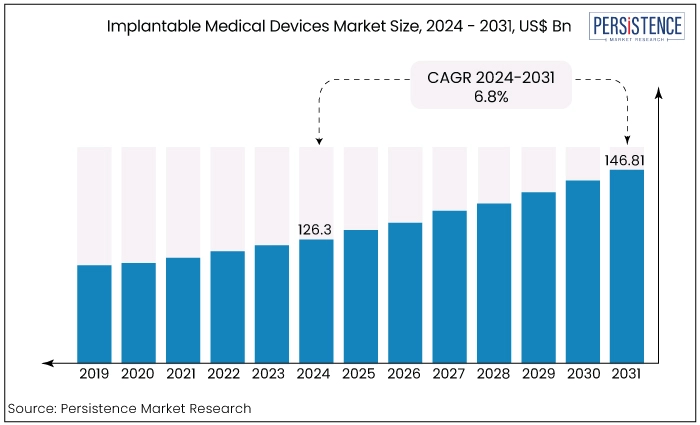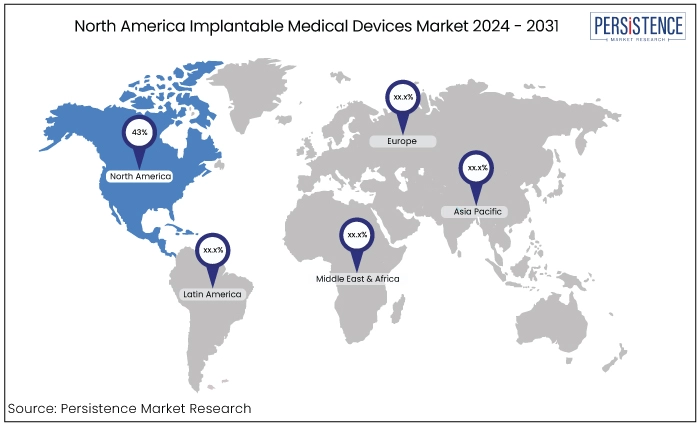Industry: Healthcare
Published Date: September-2024
Format: PPT*, PDF, EXCEL
Delivery Timelines: Contact Sales
Number of Pages: 177
Report ID: PMRREP34767
The implantable medical devices market is estimated to increase from US$126.3 Bn in 2024 to US$146.81 Bn by 2031. The market is projected to record a CAGR of 6.8% during the forecast period from 2024 to 2031. Key factors driving the market growth are the rise in the prevalence of chronic diseases and favorable reimbursement policies that helps patients for pacemaker implantation. North America region leads the market by accumulating around 43% of the market share.

Key Highlights of the Market
|
Market Attributes |
Key Insights |
|
Market Size (2024E) |
US$126.3 Bn |
|
Projected Market Value (2031F) |
US$146.81 Bn |
|
Global Market Growth Rate (CAGR 2024 to 2031) |
6.8% |
|
Historical Market Growth Rate (CAGR 2019 to 2023) |
6.1% |
|
Region |
Market Share in 2024 |
|
North America |
43% |
North America implantable medical devices market to hold significant share of around 43% in 2024. The leadership is mainly due to the region's sophisticated healthcare infrastructure, substantial healthcare spending, and a robust emphasis on technological innovation.
North America is home to numerous innovation hubs and centers of excellence in medical technology. The presence of leading medical device manufacturers, biotech firms, and research institutions drives innovation and advancements in implantable medical devices.
The United States in the region boasts a highly developed healthcare system equipped with state-of-the-art medical facilities and cutting-edge technologies. The strong foundation not only supports the growth of the implantable devices sector but also fosters ongoing advancements in medical care and treatment options.

Europe is expected to become the second-largest market for implantable medical devices globally. The growth can be largely attributed to the rising prevalence of chronic diseases. This region has a significant and growing elderly population, which increases the demand for implantable medical devices used to manage age-related health conditions. These conditions include cardiovascular diseases, orthopedic issues, and neurodegenerative disorders.
Countries in Europe generally have high levels of healthcare expenditure, which supports the acquisition of advanced medical technologies, including implantable devices. The region’s commitment to high standards of medical care ensures the adoption of innovative and effective implantable devices.
Asia Pacific market is poised for substantial growth driven by a high prevalence of chronic diseases, an aging population, and ongoing healthcare reforms aimed at infrastructure development.
The region is experiencing favorable and less stringent regulations surrounding new product development, further stimulating market expansion. According to a study by The Global Burden of Disease, the cardiovascular disease (CVD) death rate in India stands at 272 per 100,000 individuals surpassing the global average of 235. This alarming trend underscores the urgent need for advanced medical solutions in the region.
|
Category |
Market Share in 2024 |
|
Biomaterial - Metallic |
47% |
The metallic biomaterial is estimated to account for almost 47% of the market share in 2024. Metallic implants are preferred for their remarkable strength and durability making them suitable for various applications particularly in orthopedics and dentistry.
Common materials such as titanium and stainless steel are favored for their exceptional load-bearing capabilities. Titanium is highly biocompatible allowing it to be well-tolerated by the human body. This property enables titanium implants to integrate seamlessly with bone and tissue enhancing patient outcomes and longevity.
Orthopedic Implants Gain Traction in the Market
|
Category |
Market Share in 2024 |
|
Product - Orthopedic Implants |
49% |
Orthopedic implants accounted for the notable share in the market account for 49% in 2024. This category encompasses vital devices such as joint replacements, spinal implants, and trauma fixation devices.
The rising incidence of orthopedic conditions, including osteoarthritis, rheumatoid arthritis, and osteoporosis, is significantly boosting demand for these implants. Furthermore, the aging population is increasingly susceptible to orthopedic issues, further elevating the need for effective solutions.
The market is surging due to the increasing prevalence of chronic diseases, advancements in technology, and an aging population. Several notable trends are shaping the implantable medical devices market.
There is a significant rise in the incidence of chronic diseases including cardiovascular and orthopedic conditions which is driving demand for various implantable devices. The aging population is particularly vulnerable to these health issues, further increasing the need for effective medical solutions.
Healthcare reforms aimed at improving infrastructure and accessibility are enhancing the market landscape. The trend toward less stringent regulations for new product development is also noteworthy, as it encourages manufacturers to introduce cutting-edge technologies more rapidly.
Innovations such as biocompatible materials, 3D printing, and smart implantable devices are revolutionizing the industry. Moreover, the shift towards outpatient care and the increasing number of procedures performed in ambulatory surgical centers are contributing to implantable medical devices market growth.
The implantable medical devices market analysis has demonstrated impressive growth over the past few years, driven by factors such as the increasing prevalence of chronic diseases, advancements in medical technology, and growing aging population. The market for implantable medical devices expanded at a CAGR of 6.1% during the period from 2029 to 2023.
The market's expansion is further supported by healthcare reforms aimed at improving infrastructure and accessibility, which have facilitated the adoption of innovative medical solutions.
The continuous growth is expected to be fueled by ongoing technological advancements, including the development of biocompatible materials and smart implantable devices that enhance patient outcomes. The rising demand for minimally invasive procedures and outpatient care is likely to drive further adoption of implantable devices. The market is estimated to record a CAGR of 6.8% during the forecast period from 2024 to 2031.
Increasing Cardiovascular Disease Rates
One of the substantial causes for concern is the proliferation of cardiovascular illnesses (CVDs), which include coronary artery disease and heart failure among the general population.
Roughly 17.9 million deaths are attributed to cardiovascular diseases each year making them leading cause of mortality globally. Such a disheartening number highlights the critical need for viable treatment alternatives such as implanted devices to address the mounting health catastrophe that is related to these illnesses. This need is the primary factor driving the expansion of the market for implantable medical devices.
Growing Adoption of Minimally Invasive Procedures
Various benefits are associated with minimally invasive surgical treatments including fast recovery times and a lower risk of problems. As a result, there is a rapid development in the demand for these procedures.
The adoption of implantable cardiovascular devices is greatly increased. This is because these approaches often result in fewer complications, such as infections and excessive bleeding compared to traditional open procedures,
After surgery patients have less pain and discomfort increasing overall satisfaction and better health outcomes. This, in turn, contributes to a pleasant experience with healthcare and to the expansion of the market for implantable medical devices.
High Cost Associated with Implantable Devices
The substantial costs associated with implantable devices and their treatments pose significant challenges to their widespread adoption particularly in developing regions. High prices can restrict access for patients in low- and middle-income countries and consequently hindering market growth and reach.
Even in developed areas insufficient insurance coverage and reimbursement policies may leave patients facing considerable out-of-pocket expenses further complicating their ability to obtain these essential medical devices. This financial burden can deter potential users, limit overall advancements in healthcare, and hinder the growth of implantable medical devices market sales.
Strict Regulatory Policies
The approval process for implantable medical devices is both rigorous and time-consuming, often delaying market entry and elevating costs for manufacturers. Regulatory bodies, such as the FDA and EMA, mandate extensive clinical trials and documentation to ensure safety and efficacy.
Manufacturers face significant expenses related to clinical trials, quality control, and compliance with regulatory standards. Stringent requirements can pose substantial challenges impacting the overall development and availability of innovative medical devices in the market.
Integration of Digital Health Technologies
One prominent opportunity lies in the market is the integration of digital health technologies. Many manufacturers are incorporating features like remote monitoring, data analytics, and connectivity into their devices. This allows healthcare providers to track patient health in real-time and make informed decisions based on accurate data.
Such advancements not only enhance patient engagement and adherence to treatment but also enable proactive management of chronic conditions, ultimately improving patient outcomes and reducing healthcare costs through timely interventions.
Growing Demand for Minimally Invasive Procedures
Several significant implantable medical devices market opportunities lie in the increasing demand for minimally invasive procedures. As patients seek fast recovery times, reduced hospital stays, and less postoperative pain, healthcare providers are prioritizing less invasive surgical options.
The shift toward invasive surgical options present manufacturers with the chance to innovate and develop advanced implantable devices that meet these demands such as small, more efficient implants and enhanced delivery systems. By capitalizing on this trend, companies can expand their market share and improve patient satisfaction.
The market is witnessing significant growth reflecting its dynamic landscape as indicated by the latest market report. Players in the industry are actively launching new products and integrating innovative technologies to create new opportunities within the sector.
Companies in the market are adopting crucial business strategies to broaden their product lines, increase market share across various regions, invest in research and development and optimize supply chains to enhance market value.
Recent Industry Developments in the Implantable Medical Devices Market
|
Attributes |
Details |
|
Forecast Period |
2024 to 2031 |
|
Historical Data Available for |
2019 to 2023 |
|
Market Analysis |
US$ Billion for Value |
|
Key Regions Covered |
|
|
Key Market Segments Covered |
|
|
Key Companies Profiled |
|
|
Report Coverage |
|
|
Customization & Pricing |
Available upon request |
By Product
By Biomaterial
By Region
To know more about delivery timeline for this report Contact Sales

The market is estimated to increase from US$126.3 Bn in 2024 to US$146.81 Bn by 2031.
Medtronic, Abbott Laboratories, Johnson and Johnson, are some of the leading players in the market.
The orthopedic implants are the significantly growing product type in the market.
The market is predicted to exhibit a CAGR of 6.8% during the forecast period from 2024 to 2031.
A key opportunity lies in the integration of digital health technologies.